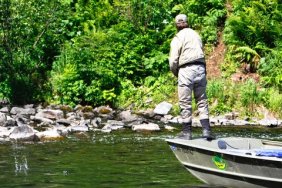 Normally in an Anatomy article we’d take a look at the design specifics of a particular type of lure, but today we’ll broaden our gaze to include a vital piece of tackle: hooks. Fishing hooks typically consist of a common, straightforward design—an eye, shank, gap, point, and barb—but variations of these elements throughout the years have resulted in dozens of hook styles on the market. Today we’ll explore the parts of a hook and what makes them so effective in the fishing world.
Normally in an Anatomy article we’d take a look at the design specifics of a particular type of lure, but today we’ll broaden our gaze to include a vital piece of tackle: hooks. Fishing hooks typically consist of a common, straightforward design—an eye, shank, gap, point, and barb—but variations of these elements throughout the years have resulted in dozens of hook styles on the market. Today we’ll explore the parts of a hook and what makes them so effective in the fishing world.
A hook’s eye serves as is its connection point to either your fishing line or the body of a lure. Ringed eyes tend to be the most common and consist of a uniform loop with the end sitting flush against the hook’s shank.
The shank of a hook spans from the eye to where the bend begins. Shanks typically come in short, medium, or long lengths, and a major role in a hook’s use on the water. For instance, short shanks are often used for finesse fishing, where their compact size and minimal weight are critical to a successful presentation. Medium shanks are the most common and can be used in an variety of fishing situations. Long shanks are used to match a longer profile of an artificial bait, such as a spinnerbait.
The gap refers to the size of the bend in a hook from the shank to its point. An average gap will do the job in most situations, but sometimes you need a wider gap. A hook with a wide gap is useful when you’re working with thicker baits, as it will ensure that the hook’s point will be exposed on the hook set.
At the end of a hook’s bend, you’ll find the tapered point that penetrates a fish’s mouth. Point shapes can vary between companies. A dull hook point won’t do a good job of catching fish, so you’ll need to keep your hooks’ points sharp by investing in a file.
Finally, you have the hook’s barb, which is designed to hold the hook in place once it penetrates the fish’s mouth. The larger the barb, the more difficult it is for the fish to get the hook free. This applies to you, though, as well, in case you find yourself hooked. Anglers who practice catch and release typically pinch their barbs with pliers, or file them down, for easy hook removal.
Each component of a hook plays an important role in catching fish. Understanding how they combine to make one of fishing’s most vital pieces of tackle will help you choose the best hook for your purposes on the water. It will also help you tailor a specific presentation for the day’s conditions so you can catch more fish. Keep that in mind when you’re stocking up, and you’re sure to discover a boost in your effectiveness this season!








